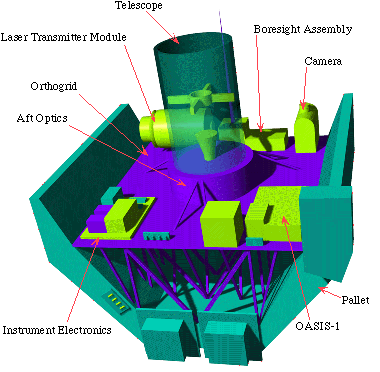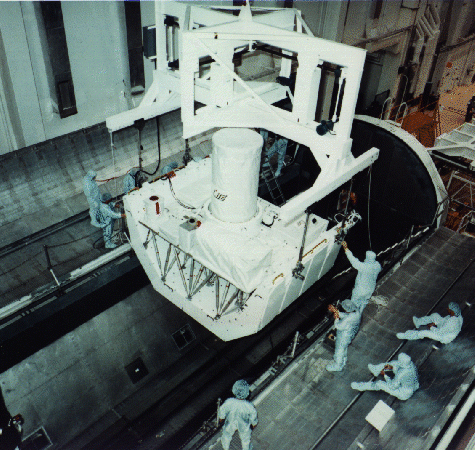| LITE Directory | |
| Home Page | |
| Mission Overview | |
| Data User's Guide | |
| Data FAQ's | |
| Science Steering Group | |
| Instrument | |
| Publications | |
| Images | |
| Photos | |
| Photos and Images | |
| Data Gallery | |
| Meta Data | |
| ISDB Data |
LITE Instrument

The LITE instrument was carried in the Shuttle cargo bay on a standard Spacelab pallet. The instrument
was mounted on an orthogrid platform attached to the pallet by 52 struts. The orthogrid is a support platform
for the instrument subsystems and was designed to be immune to thermal
deformations which could affect optical alignment. A description of the major LITE subsystems follows.
The receiver includes a one meter telescope and an aft-optics package.
The telescope collects laser light scattered from the atmosphere, and
brings it to focus in the aft optics. The aft optics includes wavelength
selective optics to separate the return signal into its three color
components. The 532 nm and 355 nm detectors are photomultiplier tubes,
while the 1064 nm detector is a silicon avalanche photodiode.
The boresight assembly consists of a two-axis motor-driven prism. Its
purpose is to align the laser beam to the telescope field-of-view so that
both point to the same column of atmosphere.
The LTM consists of two flash lamp-pumped, Q-switched Neodymium:YAG lasers
which emit simultaneously at the three harmonically related wavelengths of
1064 nm (infrared), 532 nm (visible green), and 355 nm (ultraviolet). The
two-laser system provides redundancy in case one laser fails. Only one
laser operates at a time.
The OASIS-I is a data-logging, subsystem which was used to record accelerations, acoustic
loads, strains temperatures, thermal flux and pressures during the launch,
ascent, on-orbit, descent, and landing phases of the LITE mission.
The LITE camera is a modified half-frame 35 mm camera originally used for aerial reconnaissance. It was used to
photograph the Earth's surface and cloud cover during the daylight portions of orbits when lidar data were
acquired. A 25 mm focal length lens was used, giving a coverage of 200 X 200 km2. The time interval between
photographs is approximately 21 seconds, giving roughly 20% overlap between successive frames. A GMT time stamp
recorded on each frame was used to determine the latitude and longitude on the surface of the Earth that
corresponds to the center of each frame.
LITE camera photographs may be obtained from the LITE Camera Photographs and
Photos and Images pages.
The LITE Camera Photographs page contains the entire set of LITE camera photographs.
The photographs are available as JPEG images.
The Photos and Images page contains the LITE camera photographs
coincident with daytime LITE observations.
The LITE camera photographs are displayed with color-modulated, altitude-time plots of
daytime LITE (background subtracted) signal profiles for the 532 nm wavelength.
The LITE photographs are available as JPEG images.
The Instrument Controller (IC) handles all command and data interfaces of
the LITE instrument. All subsystems could be commanded and controlled via
the IC. Health and status of the LITE instrument are monitored and
transferred to the Spacelab's Smart Flexible Multiplexer/Demultiplexer
(SFMDM). The IC software consists of over 18 real-time Ada tasks that
perform all commands and data interfaces for the IC as well as autonomous
operations.
Winker, D. M., Couch, R. H., and McCormick, M. P., An overview of LITE: NASA's
Lidar In-space Technology Experiment, Proc. IEEE, 84, 2, 164-180,
Feb. 1996.
McCormick, M. P., Winker, D. M., Browell, E. V., Coakley, J. A.,
Gardner, C. S., Hoff, R. M., Kent, G. S., Melfi, S. H., Menzies, R. T.,
Platt, C. M. R., Randall, D. A., and Reagan, J. A., Scientific investigations
planned for the Lidar In-space Technology Experiment (LITE), Bull. Amer.
Meteorol. Soc., 74, 2, 205-214, Feb. 1993.
Receiver Assembly
Boresight Assembly
Laser Transmitter Module (LTM)
Orbiter Experiments Autonomous Support Instrumentation System (OASIS-I)
Camera Assembly
Instrument Controller
Instrument Photograph

References.